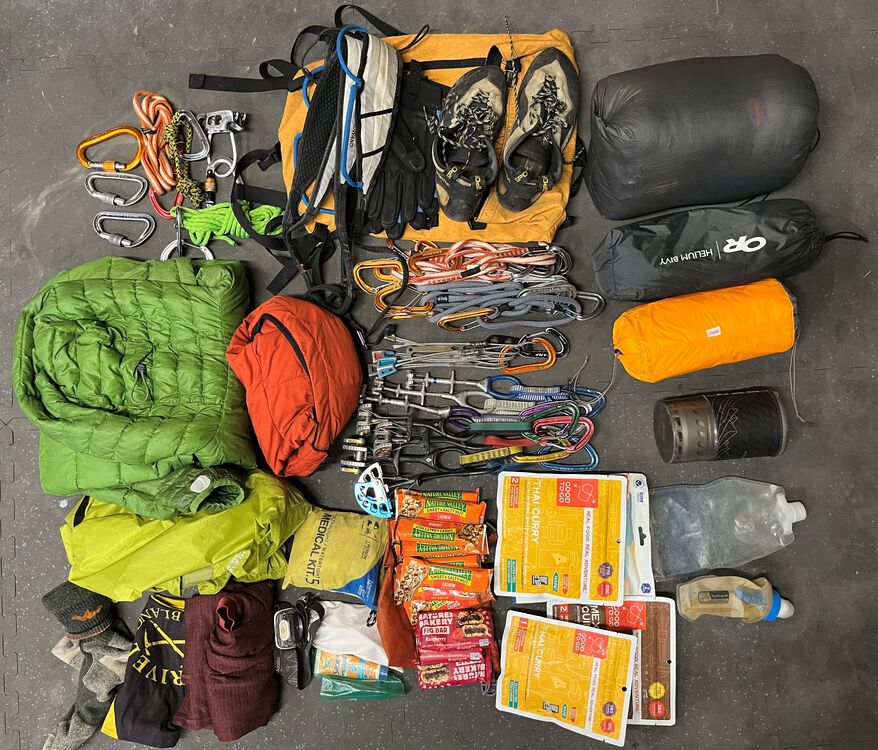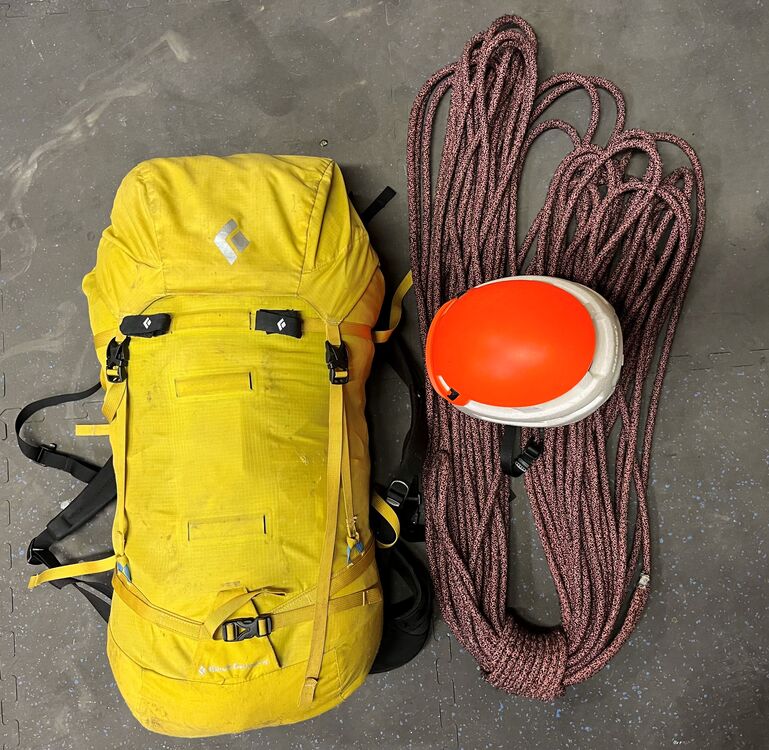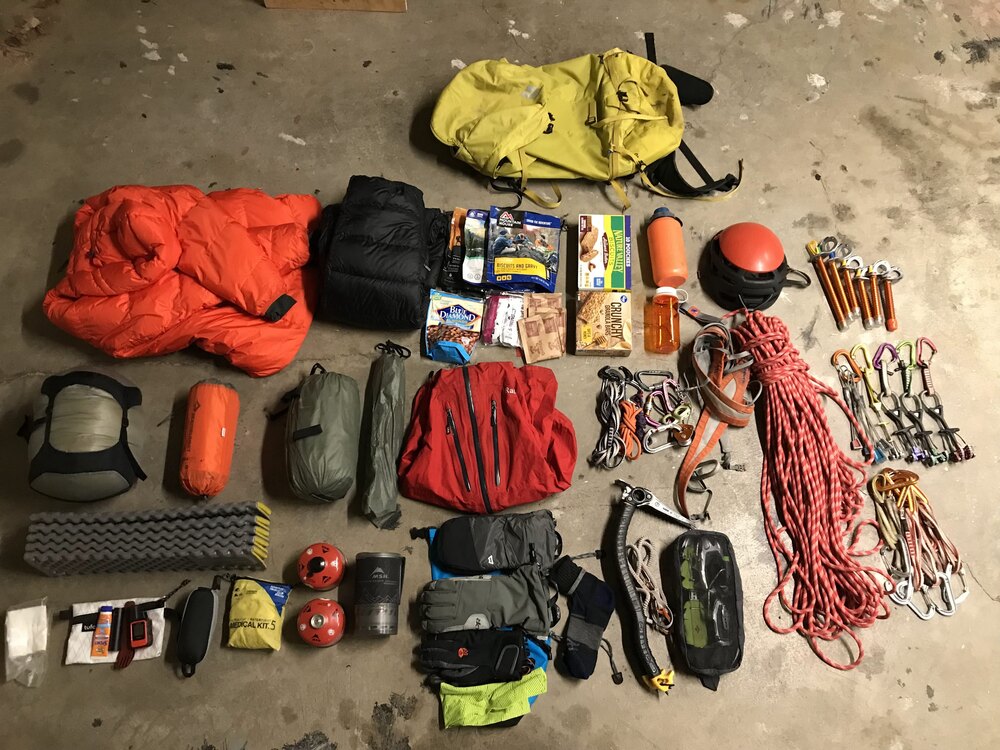Ultralight / Light-weight 75L–80L Pack Recommendations -- hike to Lower Saddle of the Grand
|
|
im currently in the same shoes as you, altough i can make it work with a 50-60L pack, and such i ordered Parbat's EL55 backpack (they have a 110L one). other alternative was Samaya Ultra50, (i have the ultra35, which is a very good backpack, but i does not carries well above 10-12kg) |
|
|
Drop the extra shoes (4 pairs?!) along with the summit pack and that can all fit in a 40l pack (your new summit pack if you really want one). Rope, 2/3 cams, and optionally climbing shoes go on the outside. No need for a big pack on an overnight trip. |
|
|
Luke Lalor wrote: The four pair of shoes are NOT factored in the total weight. See the number in red at the bottom. They are listed for reference for other trip. Dear God, who brings FOUR PAIR OF SHOES?! How can ANYONE think someone would bring four pair of shoes?! One pair for hiking/approach/walk-off, one pair (rock shoes) for climbing. Honestly, does anyone know how to read a spreadsheet?! |
|
|
Honestly, do you not know how to present a spreadsheet to others so it can be understood what you are trying do other than stuff 40 pounds of crap into 20 pound sack? That is, it is incumbent on you to present your information in way that others can understand it without a series of cliff notes. It is clear your spreadsheet does not accomplish that. And for the record only a single pair of shoes is needed for the complete Exum. In my case, I wore double leather telemarks boots (we skied up one early April, did the complete Exum that afternoon, and skied back down to a bivy in the Meadows). But that was over 30 years ago and we spent our time climbing rather than writing detailed spreadsheets so to analyze every last ounce. |
|
|
Not to sidetrack, but have you considered just going car to car and skipping all the bullshit? Take just a light 20-30L pack and be down drinking beer (the best tasting beer ever after such a climb) and pulling a swig looking up at the saddle rather than actually being there re-arranging cold rocks to try and catch 30 mins of bad rest at a time? I agree, the trip is no joke, and gone are the days, for me personally that I just pull into Lupine meadows straight from MN and run right up. But the easiest ascent of the Grand I ever had was heading up to the saddle just to see weather come in and it start to rain and snow. We waited a bit to see how things would develop, but they were just getting worse, so we bailed (hard to leave the saddle once there). The next day was crappy as well, so we just hiked around. The next morning we made our next attempt and it went smooth as silk and we felt great after the extra acclimation and warm up. Enjoying those evening beers looking UP at the mountain. The lightbulb went on…proper warmup is key in the alpine as well as hard rock climbing (not just altitude acclimation). Of course this is known, but often ignored or minimized (at least by me previously) TL;DR - something to consider: don’t just focus on the main trip event and main objective. If you’re accounting for 3 days anyway, use 2 of them for smaller scale day-climb/hike warmup objectives to get legs and lungs broken in for the Grand, then do the Grand in one continuous push traveling uber light. Can leave at midnight and just stroll up the trail in the dark at your leisure to be at the base at your planned time. From my experience, you’ll end up feeling way better and enjoying more of the Tetons in the same time. Sleep/rest at the saddle is often illusory |
|
|
Weak, can't even get back to car after skiing the Grand and had to bivy. I bet it was also an FKT, right? After all, you probably also started the cool trend of doing things light and fast three decades ago, right? I'm suprised your huge superior gonands even let you get close enough to a keyboard to type that unbelievably belittling and not-helpful post. Apologies for my rude response, just seems like constant belitting on a relatively harmless question. People, get off your high horses (without hurting yourself, it's a long way for some of you). OP: lots of good adivice here, just ignore the blowhards, they're just jelous you're just starting to climb and they peaked before the internet. Cheers, Dave |
|
|
OP, it seems like your stuff should fit into a 40-50L bag? I didn't want to just make random suggestions, so I laid out the closest approximation of your packing list with my gear to test it, and it fit into my BD Speed 40 without using the collar. It would easily fit into a 50L pack. Here's a photo of all the stuff laid out on the ground: For reference this is a 30 deg EE quilt, bivy sack, S2S pad, MSR Windburner stove and pot, 20L Tufa pack, OR down jacket, MH midlayer, OR Helium rain jacket, full rack and draws, harness and shoes, personal kit, and I think most of the misc stuff. I forgot the chalk bag and toothbrush. Here it is all packed up in a 40L bag (except the rope and the helmet, which would go outside): In reality it should be even easier than this, because that is most of the shared gear (rack, stove, first aid) all with one person. More likely, you'd split that stuff up to help with space, or the other person would carry the rope since you have the full rack and the stove. I've used this 40L pack (and similar 30L and 50L packs) for a bunch of overnight climbing, so I promise it's not just theoretical. Once you pare the pack size down, it also becomes more reasonable to climb with this bag in a stripped down form, so you can leave the summit bag behind if you want, especially for a moderate objective like The Grand. Here's a photo of the stuff that I crammed into that same 40L pack for a 4-day/3-night climb in Alaska. This is a -10 deg bag, a tent (shared with partner), big belay parka, down pants, etc. One caveat here: the rope, harness and glacier gear never go into the pack because you're always wearing them, and the sharps and closed cell pad go on the outside. If you still prefer to carry a big bag up to camp, that's totally fine Just wanted to show some examples of packing that could work for you. If you do decide to go with a big bag, I agree with other posters that you don't want to try to save ounces here, for a big pack it's worth having a good suspension and some durability. I've used the BD Mission 75 quite a bit and like it, but I suspect there are plenty of great options. Big hauler bags aren't super high tech, no need for something fancy. |
|
|
Dave Schultz wrote: Dave, while I did not quote the OP's post (two post above mine, and now added for context), the OP was using all caps (i.e. yelling) and chastising people for not understanding his spread sheet. Which in reading the thread multiple people found confusing. Thus my response. |
|
|
Scott360 wrote: In fairness to all of them, you are asking about an 80L bag for something that I wouldn’t dream of being a 50L for, and (again) I’m not exactly an ultra-light kind of guy. we’re over here wondering what the hell you need with a 10-day pack for a 2-day climb. |
|
|
First, thanks for sharing you list, and crowd sourcing. Not sure why this doesn't fit in a 65L pack. I would say that if you scale up to a bigger pack, it's just going to be heavier, but it will carry the weight you do have better. A pack that's not bursting at the seams (but not super empty and floppy) just rides better. Have fun! |
|
|
Bel Aoros wrote: how do you like EL55 |
|
|
The Blue Ice Stache 90 is insanely light and carries weight well |
|
|
John Sigmon wrote: For real 75-80L is a Denali West butt slog size load. |
|
|
Y C wrote: so far so good, but did not have enough mileage in it. Definitely a specialist bagpack. Much more comfortable than my samaya, but requires more careful packing when light and heavy things are mixed. |
|
|
Free the heel free the mind I’d leave the nuts, all but two alpine draw and #3 behind. In place bring two more smaller finger sizes and mostly shoulder slings. There tons of natural feature to use for belays. The approach took longer than the climb for us |
|
|
You might consider the ULA Catalyst (75L). While I've never used the Catalyst itself, I've got thousands of miles of use out of the slightly smaller ULA Circuit (68L). It's not as fully featured (gear loops, ice axe toggles, etc) as some of the other packs mentioned, but it has been a great pack. Despite the maximum load capacity of the Circuit being 35 lbs, I've carried 45+ lbs for extended duration and the pack carried well enough and has held up great. The Catalyst has a higher load capacity of 40 lbs, so you should be able to push it even further weight-wise. I'll note however that I've found packs that carry a lot of weight super comfortably tend to be constructed with a bit more structure and padding, which naturally bumps the bare pack weight up. Good luck on your climb and maybe I'll see you out there as I'm currently planning a nearly identical trip. |
|
|
Kyle Tarry wrote: I have nothing to add but you are an excellent packer. I need to re-evaluate how I pack things, haha. I have a similar loadout but seems like I need more like 50L of space rather than the 40 (BD Speed 50 for reference). |
|
|
Bel Aoros wrote: how about the material? Is it thicker than Samaya's? I noticed that the main body's material of samaya's is 150D DCF |
|
|
Maybe drop some shoes? Four pairs seems like a lot. I think my rack for upper Exum was a 15L pack with some water and a baggie of mushrooms. |
|
|
Y C wrote: the bottom panel is thicker and stiffer thank the 150D (but samaya uses fully woven 300D UHMWPE on the bottom which is much more robust ), the main fabric is thinner but its made from UHMWPE instead of mostly polyester, the rolltop is as thin as dcf but feels much more more robust. Time will tell but i think its around the same ballpark regarding abrasion and higher tensile strenght. Also Aluula is much more slippier especially noticable at the shoulderstraps |

 Continue with onX Maps
Continue with onX Maps Sign in with Facebook
Sign in with Facebook

























